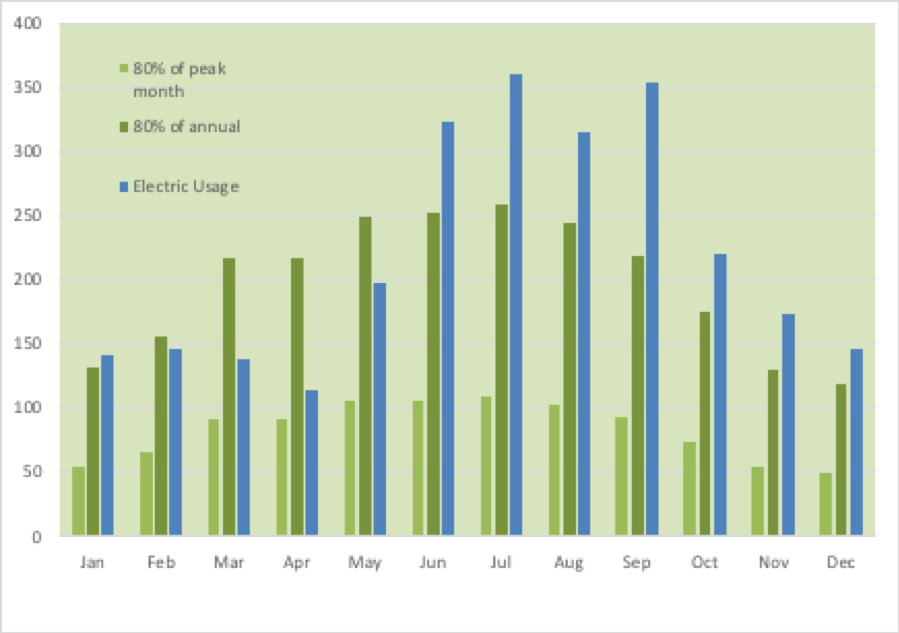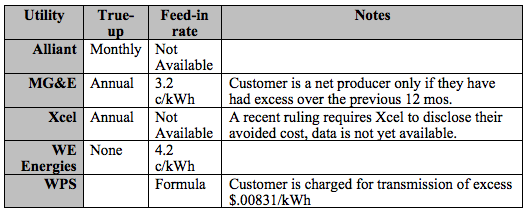Net Metering in Wisconsin
If you’re putting solar PV on your home you may have heard the term “net metering” and wondered what it means. Even if you think you know what it means, there are some details about it that vary greatly depending on your utility. These may affect the size of the array you decide to install, and how you operate it. In this article I’ll explain what net metering is, why we have it and what you should know to make the best decision about your installation and how you use it.
The Wisconsin Public Service Commission (PSC) established rules in 1982 to require investor-owned and public utilities to offer net metering (it’s optional for co-ops). This means that when you install solar the utility will provide a meter that can measure the incoming (imported) and outgoing (exported) electricity separately. Periodically, either monthly or annually, they’ll look at the difference between imports and exports (true-up). If you had more imports than exports, you’re a net consumer and all of your exported electricity will be credited at the same price you are charged. If you exported more than you imported then you’re a net producer. You’ll still be fully credited for the solar production equal to your usage and you’ll be paid for the overproduction, but at the avoided energy cost. This is usually 3-4c/kWh, far below the retail rate. Since utilities are granted monopoly status by the PSC, you can’t go somewhere else to get a better price.
Getting back to the original question, how does net metering policy affect the array size you choose? Primarily because of the difference between monthly and annual true-up. If your utility has annual true-up, then you size your panels for the total annual usage, which doesn’t tend to vary much in most households. For example, if your household uses 5000kWh each year and each kW of solar produces 1250kWh annually then you would need 4kW of panels for your array. Most installers recommend reducing this amount by 20% to ensure that you don’t overproduce, resulting in a 3.2 kW array that generates 80% of your annual electric use.
However, if your utility has monthly true-up then your array size depends on your use in the month of the year that you are most likely to overproduce. Monthly variations are very large. In most homes April is the month when you are most likely to create surplus electricity because you don’t need it for heating or cooling but there’s still plenty of sunshine. In the example, the 3.2kW array produces twice as much electricity as is needed in April. This results in a recommended array size of 1.7kW and only 43% of annual usage coming from solar. Figure 1 shows the monthly use and production for the two options.
Clearly, the utilities with annual true-up are doing more to promote solar. See Table 1 to find out who they are. A smaller array will be cheaper, and probably reach payback in about the same time. However, if you’re doing this to reduce your fossil fuel usage then it is a big deal. You also save a lot more money when you make more of your own electricity. And there may be something you can do about it, by using more.
Your house probably uses fossil fuels for the furnace and water – maybe your stove and clothes dryer too. Your car probably uses gasoline. If you can convert these to electric then you’ll be using fewer fossil fuels and still getting full credit for your solar electricity. This way you’re still sending your utility the message that you want to use less fossil fuels, while also sending them less of your money.
The car and furnace are the biggest users, and it’s expensive to replace them. You can take small steps though by putting electric heaters (on thermostats and timers) in the rooms you use the most and turning down the heat in the rest of the rooms. There’s no way to convert your car to electric gradually, but if you buy one (they are available used for reasonable prices) be sure to get one that allows 2-way charging like the Nissan Leaf. Then it can double as your home storage battery / emergency power and a way to store solar energy so you can use it later instead of selling it cheap. Other appliances can be replaced with electric models as finances allow.
You can still keep track of whether your electric usage is increasing or decreasing, and by how much, even though you no longer have a direct measurement of it. Any electricity from your panels that you use on your site is called behind the meter usage. With a 2-way meter you can calculate total usage (if your solar array comes with monitoring) by subtracting your exported electricity from your array output. Your total usage is the imported amount plus the behind-the-meter amount.
Conclusions
Net metering is one of the factors that will determine the size of solar array that best meets your needs. If your utility has annual true-up then you’ll get the quickest payback and best long-term savings with a larger system. If not, the size for best economics is about half as large. You can get bigger savings if you electrify appliances and vehicles that are now using fossil fuels. Be sure to make a good estimate of the electric needs of these additional items so you can size your array correctly.



